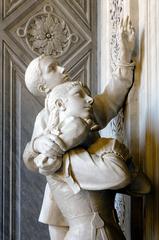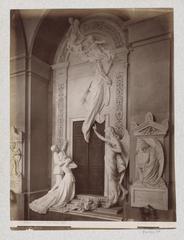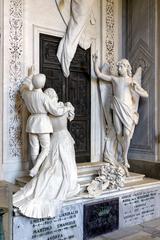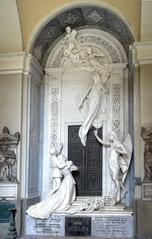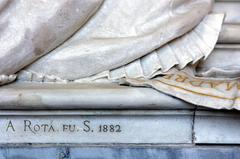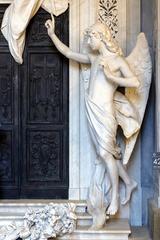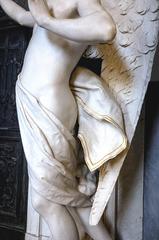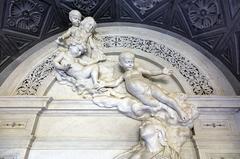
Tomba Gnecco Visiting Hours, Tickets, and Complete Guide to Genoa’s Historical Sites
Date: 14/06/2025
Introduction to Tomba Gnecco and Its Artistic Legacy
Tomba Gnecco, set within the Cimitero Monumentale di Staglieno in Genoa, Italy, is a masterpiece of funerary art and a reflection of the city’s cultural evolution during the late 19th century. Commissioned in 1882 by the Gnecco family, the tomb represents not only personal grief but also the aspirations of Genoa’s burgeoning bourgeoisie. Fusing Neoclassical, Realist, and Symbolist styles, the monument’s narrative sculpture—an angel leading a soul heavenward as two siblings remain below—embodies themes of separation, loss, and hope. As part of Staglieno, one of Europe’s most renowned cemeteries, Tomba Gnecco invites visitors to explore Genoa’s history, social dynamics, and artistic innovation.
For further details and official updates, consult the Staglieno Cemetery website, the Visit Genoa tourism portal, and the European Cemeteries Route. For on-site audio guides, try the AR-Tour Guide via the Audiala app.
Table of Contents
- Introduction
- Historical Context: The Gnecco Family and Genoa’s Transformation
- Artistic Analysis of Tomba Gnecco
- Visiting Tomba Gnecco: Practical Information
- Cultural Significance and Ongoing Preservation
- Frequently Asked Questions
- Conclusion and Visitor Recommendations
- References and Further Reading
Historical Context: The Gnecco Family and Genoa’s Transformation
The Gnecco family were prominent members of Genoa’s rising bourgeoisie during the industrial boom that followed Italian unification. Their decision to commission an elaborate tomb in 1882 was both a personal act of remembrance and a public statement of social status. Such monuments were common among Genoa’s upper middle class, who sought to immortalize their legacies through art and architecture (Staglieno official site).
Artistic Analysis of Tomba Gnecco
Narrative Realism and Emotional Impact
At the heart of Tomba Gnecco’s artistic significance is its vivid realism. The monument’s composition—an angel lifting a soul heavenward as grieving siblings remain earthbound—captures the emotional rupture of bereavement with lifelike detail. The figures’ postures and expressions communicate profound sorrow and hope, making the tomb not just a memorial, but a powerful narrative sculpture (AR-Tour Guide).
Symbolism and Iconography
Tomba Gnecco’s iconography draws on Christian and civic symbols: angels represent spiritual guidance; veiled figures suggest the transition from life to death; olive branches and laurel wreaths symbolize peace and victory over death; and the use of books or scrolls alludes to virtue and wisdom (Symbols Project). These elements articulate themes of faith, hope, and the enduring memory of the deceased.
Materials and Techniques
The monument is crafted primarily from fine marble, with bronze details on the door. Sculptors employed advanced techniques to capture realistic drapery, expressive faces, and dynamic motion, all set within Staglieno’s grand architectural landscape (AR-Tour Guide).
Visiting Tomba Gnecco: Practical Information
Hours, Tickets, and Entry
- Opening Hours: Staglieno Cemetery is generally open daily from 7:30 AM to 5:00 PM, with last entry 30 minutes before closing. On December 25 and Easter, hours are 7:30 AM to 1:00 PM. Closed on January 1 and 6, Easter Monday, June 24, August 15, and December 26 (unless these fall on a Sunday) (Cemeteries Route).
- Tickets: Admission is free of charge. Special guided tours may require advance booking and a fee.
Accessibility
- Main avenues are paved and partially accessible by wheelchair, but access to Tomba Gnecco may be challenging due to terrain. Visitors with limited mobility should contact the cemetery administration in advance for assistance.
Getting There and Navigation
- By Car: Take the Genova Est exit; parking is available near the entrance.
- By Public Transport: AMT lines 13, 14, 34, and 48 serve the cemetery. From Brignole station, take bus 14; from Principe, take bus 34. From the airport, use Volabus (line 100) to Brignole, then transfer (Staglieno official site).
- Maps: Obtain at the entrance or download from the official site.
Guided Tours and Visitor Experience
- Guided Tours: Offered one weekend per month, starting at the statue of Faith near the Pantheon. Tours in English and other languages require advance booking. Contact +39 010 5576874/909 or [email protected].
- Self-Guided Itineraries: Marked routes are available; non-Italian speakers may want a translation app.
- Photography: Permitted for personal use; be discreet and respectful.
Etiquette and Facilities
- Dress modestly, maintain silence, and do not touch monuments.
- Restrooms are near the main entrance; bring water as there are no cafés on site.
- Large groups should avoid blocking pathways.
Cultural Significance and Ongoing Preservation
Tomba Gnecco embodies the shift toward realism and personal narrative in 19th-century funerary art. Its allegorical and symbolic language reflects Genoa’s civic pride and spiritual beliefs. The monument’s ongoing preservation is a testament to the city’s commitment to safeguarding its cultural and artistic legacy for future generations (Comune di Genova, Staglieno Restauri 2024).
Frequently Asked Questions
Q: What are the visiting hours for Tomba Gnecco?
A: The cemetery is open daily from 7:30 AM to 5:00 PM. Special hours and closures apply on select holidays.
Q: Is there an entrance fee?
A: Entry is free; guided tours may have a fee.
Q: How do I get to the cemetery?
A: By car (Genova Est exit), public transport (AMT lines from main stations), or taxi.
Q: Is the cemetery accessible for people with disabilities?
A: Some areas are accessible, but terrain can be uneven. Contact administration for support.
Q: Are tours available in English?
A: Yes, but booking in advance is recommended.
Q: Is photography allowed?
A: Yes, for personal use and with respect for the site.
Conclusion and Visitor Recommendations
Tomba Gnecco is a profound intersection of art, history, and memory within one of Europe’s grandest cemeteries. Its sculptural narrative, blending realism and symbolism, offers a deep reflection on Genoa’s historical identity and the evolution of funerary art. Visitors are encouraged to explore the tomb as part of a broader discovery of Staglieno and Genoa’s rich cultural landscape.
Plan your visit by consulting official resources, and enhance your experience with the Audiala app’s interactive tours. For the latest updates on events, tours, and restoration projects, follow Staglieno and Genoa’s tourism channels.
References and Further Reading
- Staglieno Cemetery Official Website
- Cimitero Monumentale di Staglieno
- Materially Speaking: Genoa Cemetery
- Tomba Gnecco on Cemeteries Route
- Visit Genoa Tourism
- AR-Tour Guide: Tomba Gnecco
- European Cemeteries Route
- Comune di Genova, Staglieno Restauri 2024
- Symbols Project: Tomba Gnecco
- Bimbe in Viaggio: Monumental Cemetery Staglieno Genoa

